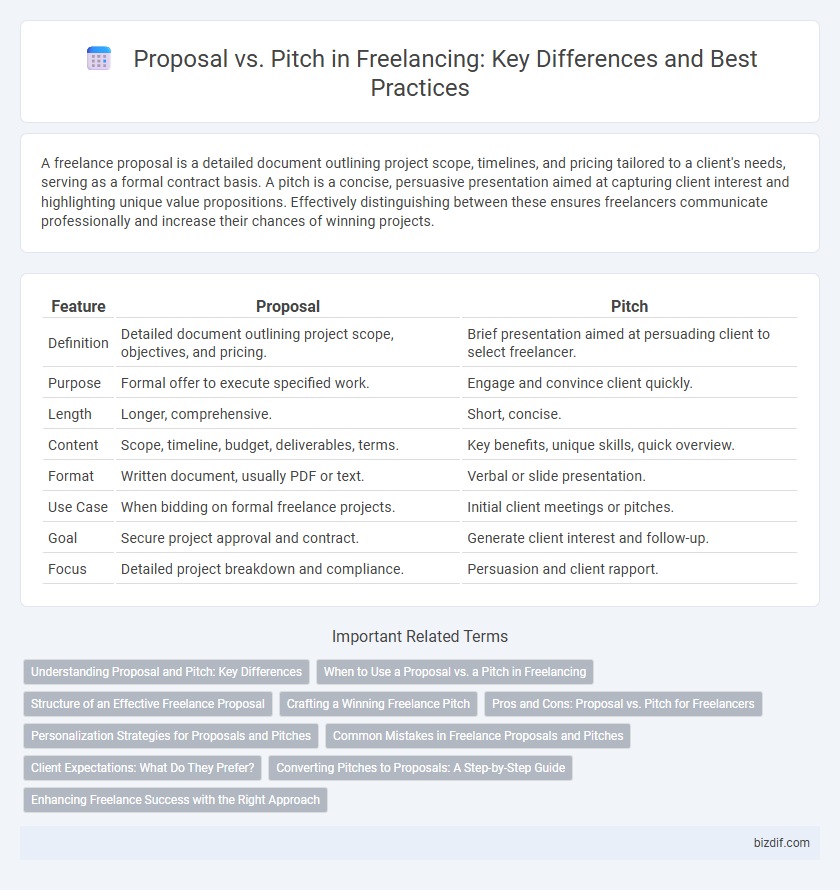A freelance proposal is a detailed document outlining project scope, timelines, and pricing tailored to a client's needs, serving as a formal contract basis. A pitch is a concise, persuasive presentation aimed at capturing client interest and highlighting unique value propositions. Effectively distinguishing between these ensures freelancers communicate professionally and increase their chances of winning projects.
Table of Comparison
| Feature | Proposal | Pitch |
|---|---|---|
| Definition | Detailed document outlining project scope, objectives, and pricing. | Brief presentation aimed at persuading client to select freelancer. |
| Purpose | Formal offer to execute specified work. | Engage and convince client quickly. |
| Length | Longer, comprehensive. | Short, concise. |
| Content | Scope, timeline, budget, deliverables, terms. | Key benefits, unique skills, quick overview. |
| Format | Written document, usually PDF or text. | Verbal or slide presentation. |
| Use Case | When bidding on formal freelance projects. | Initial client meetings or pitches. |
| Goal | Secure project approval and contract. | Generate client interest and follow-up. |
| Focus | Detailed project breakdown and compliance. | Persuasion and client rapport. |
Understanding Proposal and Pitch: Key Differences
A proposal in freelancing is a detailed document outlining the scope, deliverables, timeline, and pricing for a project, tailored to address the client's specific needs and requirements. A pitch is a concise, persuasive presentation aimed at capturing the client's interest quickly through highlighting key ideas, skills, and unique value propositions. Understanding the difference helps freelancers craft more effective communication strategies, ensuring proposals provide comprehensive project plans while pitches focus on engaging and convincing potential clients.
When to Use a Proposal vs. a Pitch in Freelancing
A proposal is best used when detailed project specifications, budget, and timelines need to be outlined clearly to a client, often for larger or more complex freelance jobs. A pitch is more effective in initial stages or competitive scenarios where freelancers aim to quickly persuade clients with concise value propositions and creative ideas. Understanding whether to deploy a proposal or a pitch depends on the project scope, client expectations, and the stage of the freelancer-client relationship.
Structure of an Effective Freelance Proposal
An effective freelance proposal features a clear structure including an engaging introduction, a detailed scope of work, and a transparent pricing section, addressing client needs precisely. Emphasizing deliverables, timelines, and value propositions enhances credibility and client trust. Tailoring each proposal to the specific project requirements significantly improves the chances of securing freelance contracts.
Crafting a Winning Freelance Pitch
Crafting a winning freelance pitch requires clear communication of your unique skills, project understanding, and value proposition tailored to the client's needs. Unlike a formal proposal, a pitch should be concise, engaging, and highlight how your expertise solves specific problems or enhances the client's objectives. Focusing on a personalized approach and demonstrating past success through relevant examples increases the likelihood of securing freelance projects.
Pros and Cons: Proposal vs. Pitch for Freelancers
Proposals offer freelancers a detailed, formal presentation of skills and project plans, enhancing credibility and clarity but often requiring significant time investment. Pitches allow for a dynamic, concise delivery that can quickly capture client interest though they risk lacking depth and detailed information. Choosing between a proposal and a pitch depends on the project complexity, client expectations, and the freelancer's ability to tailor communication effectively.
Personalization Strategies for Proposals and Pitches
Personalization strategies for proposals and pitches significantly increase the chances of winning freelance projects by tailoring the content to address the client's specific needs and pain points. Freelancers should research the client's industry, business goals, and previous work to craft unique value propositions that resonate with the target audience. Incorporating client-specific data, using their language style, and clearly outlining how the freelancer's skills solve the client's challenges enhances engagement and demonstrates genuine interest.
Common Mistakes in Freelance Proposals and Pitches
Common mistakes in freelance proposals and pitches include lack of personalization, failing to address the client's specific needs, and vague project scopes. Overloading proposals with unnecessary jargon or overly lengthy content often leads to disengagement from potential clients. Neglecting to highlight relevant skills, past successes, and clear deliverables reduces the chances of winning competitive freelance projects.
Client Expectations: What Do They Prefer?
Clients often prefer proposals because they provide detailed project scope, timelines, and cost breakdowns, aligning expectations clearly. Pitches tend to emphasize creativity and unique value propositions but may lack comprehensive project details. Understanding that clients seek clarity and assurance, combining a well-structured proposal with a compelling pitch can effectively meet their preferences.
Converting Pitches to Proposals: A Step-by-Step Guide
Converting pitches to proposals involves outlining clear objectives, defining scope, and detailing deliverables to transform client interest into structured commitments. Emphasizing client needs through personalized content and incorporating relevant case studies enhances proposal effectiveness. Precise budget estimates and timelines articulate professionalism, increasing the likelihood of winning freelance projects.
Enhancing Freelance Success with the Right Approach
Crafting a targeted proposal that clearly outlines project goals, deliverables, and timelines enhances trust and sets clear expectations with clients. A compelling pitch emphasizes unique skills and value propositions, capturing client interest and differentiating freelancers from competitors. Combining a data-driven proposal with a persuasive pitch increases the likelihood of winning projects and building long-term freelance success.
Proposal vs Pitch Infographic

 bizdif.com
bizdif.com